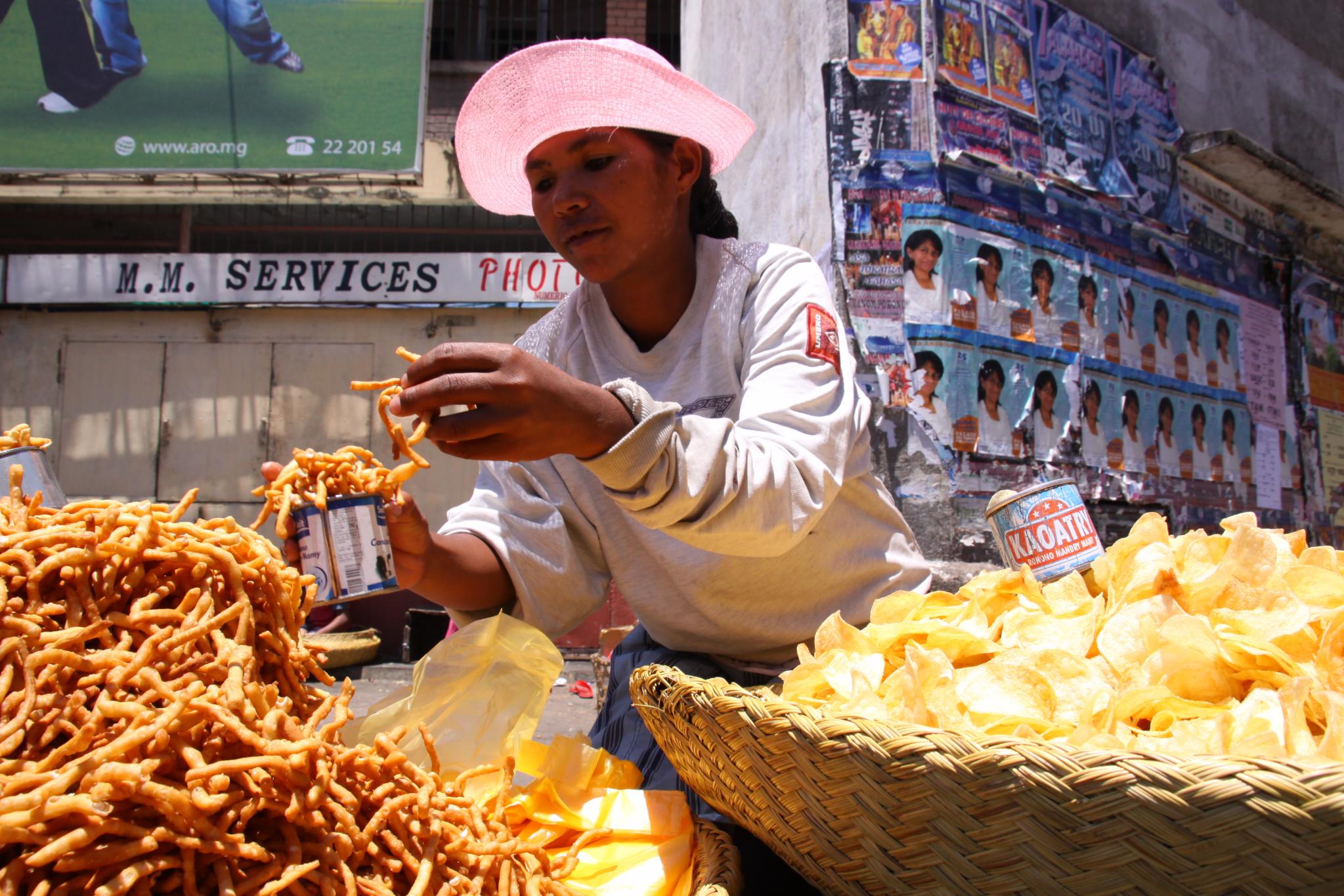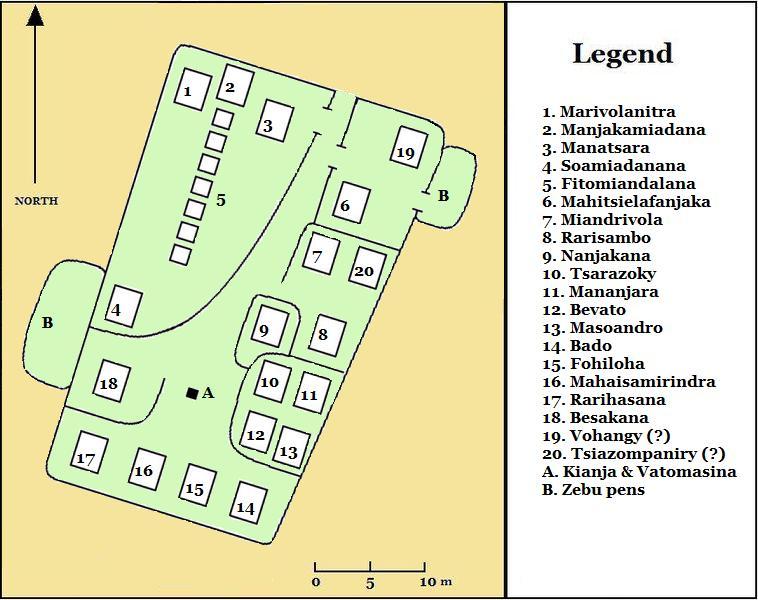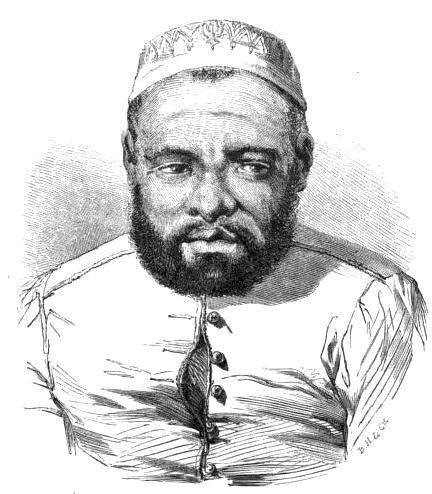|
Sihanaka
The Sihanaka are a Malagasy ethnic group concentrated around Lake Alaotra and the town of Ambatondrazaka in central northeastern Madagascar. Their name means the "people of the swamps" in reference to the marshlands around Lake Alaotra that they inhabit. While rice has long been the principal crop of the region, by the 17th century, the Sihanaka had also become wealthy traders in slaves and other goods, capitalizing on their position on the main trade route between the capital of the neighboring Kingdom of Imerina at Antananarivo and the eastern port of Toamasina. At the turn of the 19th century they came under the control of the Boina Kingdom before submitting to Imerina, which went on to rule over the majority of Madagascar. Today the Sihanaka practice intensive agriculture and rice yields are higher in this region than elsewhere, placing strain on the many unique plant and animal species that depend on the Lake Alaotra ecosystem for survival. The Sihanaka have a generally ega ... [...More Info...] [...Related Items...] OR: [Wikipedia] [Google] [Baidu] |
Andrianampoinimerina
Andrianampoinimerina () (1745–1810) ruled the Kingdom of Imerina on Madagascar from 1787 until his death. His reign was marked by the reunification of Imerina following 77 years of civil war, and the subsequent expansion of his kingdom into neighboring territories, thereby initiating the unification of Madagascar under Merina rule. Andrianampoinimerina is a cultural hero and holds near mythic status among the Merina people, and is considered one of the greatest military and political leaders in the history of Madagascar. Andrianampoinimerina took power upon deposing his uncle, King Andrianjafy, who had ruled over Imerina Avaradrano (Northern Imerina). Prior to Andrianampoinimerina's reign, Imerina Avaradrano had been locked in conflict with the three other neighboring provinces of the former kingdom of Imerina that had last been unified under King Andriamasinavalona a century before. Andrianampoinimerina established his capital at the fortified town of Ambohimanga, a site of ... [...More Info...] [...Related Items...] OR: [Wikipedia] [Google] [Baidu] |
Malagasy People
The Malagasy (french: Malgache) are an Austronesian-speaking African ethnic group native to the island country of Madagascar. Traditionally, the population have been divided by subgroups (tribes or ethnicities). Examples include "Highlander" (ethnically Austronesian/Malay-Indonesian with less Bantu ancestry) groups such as the Merina and Betsileo of the central highlands around Antananarivo, Alaotra ''(Ambatondrazaka)'' and Fianarantsoa, and the "coastal dwellers" (ethnically Bantu with less Austronesian ancestry) with tribes like the Sakalava, Bara, Vezo, Betsimisaraka, Mahafaly, etc. The Merina are also further divided into two subgroups. The “Merina A” are the Hova and Andriana, and have an average of 30–40% Bantu ancestry. The second subgroup is the “Merina B”, the Andevo, who have an average of 40-50% Bantu ancestry. They make up less than 1/3 of Merina society. The Malagasy population was 2,242,000 in the first census in 1900. Their population experienced ... [...More Info...] [...Related Items...] OR: [Wikipedia] [Google] [Baidu] |
Merina People
The Merina people (also known as the Imerina, Antimerina, or Hova) are the largest ethnic group in Madagascar.Merina people Ethnic Groups of Madagascar Encyclopædia Britannica They are the "highlander" Malagasy ethnic group of the African island and one of the country's eighteen official ethnic groups. Their origins are mixed, predominantly with |
Rova Of Antananarivo
The Rova of Antananarivo ( mg, Rovan'i Manjakamiadana ) is a royal palace complex ('' rova'') in Madagascar that served as the home of the sovereigns of the Kingdom of Imerina in the 17th and 18th centuries, as well as of the rulers of the Kingdom of Madagascar in the 19th century. Its counterpart is the nearby fortified village of Ambohimanga, which served as the spiritual seat of the kingdom in contrast to the political significance of the Rova in the capital. Located in the central highland city of Antananarivo, the Rova occupies the highest point on Analamanga, formerly the highest of Antananarivo's many hills. Merina king Andrianjaka, who ruled Imerina from around 1610 until 1630, is believed to have captured Analamanga from a Vazimba king around 1610 or 1625 and erected the site's first fortified royal structure. Successive Merina kings continued to rule from the site until the fall of the monarchy in 1896, frequently restoring, modifying or adding royal structures within ... [...More Info...] [...Related Items...] OR: [Wikipedia] [Google] [Baidu] |
Madagascar
Madagascar (; mg, Madagasikara, ), officially the Republic of Madagascar ( mg, Repoblikan'i Madagasikara, links=no, ; french: République de Madagascar), is an island country in the Indian Ocean, approximately off the coast of East Africa across the Mozambique Channel. At Madagascar is the world's second-largest island country, after Indonesia. The nation is home to around 30 million inhabitants and consists of the island of Madagascar (the fourth-largest island in the world), along with numerous smaller peripheral islands. Following the prehistoric breakup of the supercontinent Gondwana, Madagascar split from the Indian subcontinent around 90 million years ago, allowing native plants and animals to evolve in relative isolation. Consequently, Madagascar is a biodiversity hotspot; over 90% of its wildlife is endemic. Human settlement of Madagascar occurred during or before the mid first millennium AD by Austronesian peoples, presumably arriving on outrigger cano ... [...More Info...] [...Related Items...] OR: [Wikipedia] [Google] [Baidu] |
Austronesian Peoples
The Austronesian peoples, sometimes referred to as Austronesian-speaking peoples, are a large group of peoples in Taiwan, Maritime Southeast Asia, Micronesia, coastal New Guinea, Island Melanesia, Polynesia, and Madagascar that speak Austronesian languages. They also include indigenous ethnic minorities in Vietnam, Cambodia, Myanmar, Thailand, Hainan, the Comoros, and the Torres Strait Islands. The nations and territories predominantly populated by Austronesian-speaking peoples are sometimes known collectively as Austronesia. Based on the current scientific consensus, they originated from a prehistoric seaborne migration, known as the Austronesian expansion, from pre- Han Taiwan, at around 1500 to 1000 BCE. Austronesians reached the northernmost Philippines, specifically the Batanes Islands, by around 2200 BCE. Austronesians used sails some time before 2000 BCE. In conjunction with their use of other maritime technologies (notably catamarans, outrigger boats, lashed ... [...More Info...] [...Related Items...] OR: [Wikipedia] [Google] [Baidu] |
Lac Alaotra Bamboo Lemur
The Lac Alaotra bamboo lemur (''Hapalemur alaotrensis''), also known as the Lac Alaotra gentle lemur, Alaotran bamboo lemur, Alaotran gentle lemur, Alaotra reed lemur, or locally as the ', is a bamboo lemur. It is endemic to the reed beds in and around Lac Alaotra, in northeast Madagascar. It is about long, with a similar length tail, and is a brownish-gray colour. It is the only bamboo lemur to live in and feed on papyrus reeds, and other reeds and grasses, and some authorities argue that it should be regarded as a subspecies of the eastern lesser bamboo lemur (''Hapalemur griseus''). The population of this lemur has been declining because of habitat destruction and the International Union for Conservation of Nature has rated it as being " critically endangered". Taxonomy The classification of the'' bandro'' is disputed, with some classifying it as a subspecies of '' Hapalemur griseus'', while others see it as a separate species. Current genetic data do not support species ... [...More Info...] [...Related Items...] OR: [Wikipedia] [Google] [Baidu] |
Corvée
Corvée () is a form of unpaid, forced labour, that is intermittent in nature lasting for limited periods of time: typically for only a certain number of days' work each year. Statute labour is a corvée imposed by a state for the purposes of public works. As such it represents a form of levy (taxation). Unlike other forms of levy, such as a tithe, a corvée does not require the population to have land, crops or cash. The obligation for tenant farmers to perform corvée work for landlords on private landed estates was widespread throughout history before the Industrial Revolution. The term is most typically used in reference to medieval and early modern Europe, where work was often expected by a feudal landowner (of their vassals), or by a monarch of their subjects. The application of the term is not limited to that time or place; the corvée has existed in modern and ancient Egypt, ancient Sumer, ancient Rome, China, Japan, everywhere in continental Europe, the Incan civ ... [...More Info...] [...Related Items...] OR: [Wikipedia] [Google] [Baidu] |
French Madagascar
The Colony of Madagascar and Dependencies (french: Colonie de Madagascar et dépendances) was a French colony off the coast of Southeast Africa between 1897 and 1958 in what is now Madagascar. The colony was formerly a protectorate of France known as Malagasy Protectorate. The protectorate became a colony, following Queen Ranavalona III's exile to island of Réunion. In 1958, the colonial administration in Madagascar was abolished, and it became autonomous territory of the French Community as the Malagasy Republic, which existed until 1975. History Background and French protectorate The United Kingdom had been an ally of Madagascar. In May 1862, John Russell, 1st Earl Russell, Britain's foreign secretary instructed Connolly Pakenham that Radama II should keep the country away from foreign powers. In 1882, the French started to occupy much of Madagascar's northern and western territories. In 1883, the Franco-Hova Wars commenced between France and Merina Kingdom, th ... [...More Info...] [...Related Items...] OR: [Wikipedia] [Google] [Baidu] |
Papyrus
Papyrus ( ) is a material similar to thick paper that was used in ancient times as a writing surface. It was made from the pith of the papyrus plant, '' Cyperus papyrus'', a wetland sedge. ''Papyrus'' (plural: ''papyri'') can also refer to a document written on sheets of such material, joined side by side and rolled up into a scroll, an early form of a book. Papyrus is first known to have been used in Egypt (at least as far back as the First Dynasty), as the papyrus plant was once abundant across the Nile Delta. It was also used throughout the Mediterranean region. Apart from a writing material, ancient Egyptians employed papyrus in the construction of other artifacts, such as reed boats, mats, rope, sandals, and baskets. History Papyrus was first manufactured in Egypt as far back as the fourth millennium BCE.H. Idris Bell and T.C. Skeat, 1935"Papyrus and its uses"(British Museum pamphlet). The earliest archaeological evidence of papyrus was excavated in 2012 and ... [...More Info...] [...Related Items...] OR: [Wikipedia] [Google] [Baidu] |
Sakalava
The Sakalava are an ethnic group of Madagascar. They are found on the western and northwest region of the island, in a band along the coast. The Sakalava are one of the smaller ethnic groups, constituting about 6.2 percent of the total population, that is over 1,210,000 in 2014. Their name means "people of the long valleys." They occupy the western edge of the island from Toliara in the south to the Sambirano River in the north. Ethnic identity The Sakalava denominate a number of smaller ethnic groups that once comprised an empire, rather than an ethnic group in its own right. The origin of the word ''Sakalava'' itself is still subject to controversy, as well as its actual meaning. The most common explanation is the modern Malagasy translation of Sakalava meaning long ravines, denoting the relatively flat nature of the land in western Madagascar. Another theory is that the word is possibly from the Arabic '' saqaliba'', which is in turn derived from Late Latin ''sclavus'', mean ... [...More Info...] [...Related Items...] OR: [Wikipedia] [Google] [Baidu] |
Menalamba Rebellion
The ''Menalamba'' rebellion was an uprising in Madagascar by the Sakalava people that emerged in central Madagascar in response to the French capture of the royal palace in the capital city of Antananarivo in September 1895. it spread rapidly in 1896, threatening the capital, but French forces were successful in securing the surrender of many rebel groups in 1897. Elements of the rebellion continued sporadically until 1903. Background French diplomatic and military claims over the island of Madagascar - ongoing for more than four decades - intensified under the reigns of Queen Ranavalona II and Queen Ranavalona III, the island's final monarchs.Oliver, Samuel. ''Madagascar: An Historical and Descriptive Account of the Island and its Former Dependencies, Volume 1.'' Macmillan and Co., 1886. Following a successful campaign under General Jacques Duchesne, France officially annexed Madagascar on January 1, 1896. That August, the French declared Madagascar to be their colony and exiled ... [...More Info...] [...Related Items...] OR: [Wikipedia] [Google] [Baidu] |







